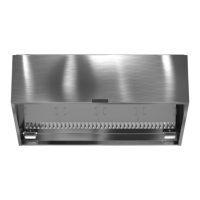Kitchen Hoods • Type I and Type II 15
Front Enclosure
End Enclosure Panels
Plate Shelf
Standing
Seam
Plate Shelf with Duct Enclosure Installation
If the proximity hood is provided with a plate shelf, this
will be factory mounted to the hood (shown loose in
figure below). Similar to the standard enclosure panel
installation procedures, make sure the hood is hung in
position with all the ductwork attached and fire system
and electrical connections completed before attaching
the enclosures.
1. Tack-weld or clamp end enclosure panels into place
(clamps provided).
2. Attach the end enclosure panels to the wall (fasteners
are not provided).
3. Position the front enclosure panel(s) on the hood and
bolt to the end enclosure with the 5/16 inch bolts
provided.
4. Tack-weld or clamp the front enclosure panel(s)
to the hood. If clamps are used, they must be
positioned 4inches (100 mm) from the ends and in
the center of the front enclosure panel.
5. To allow for ease of cleaning, caulk the external
seams with NSF Approved silicone caulk (GE
SCS1009, or its equivalent). The caulk is not
provided.
CAUTION
According to NFPA 96, Ch. 8-3 Replacement Air:
Replacement air quantity shall be adequate to prevent
negative pressures in the commercial cooking area(s)
from exceeding 4.98 Pa (0.02 in. wg).
NOTE
The airflow rates were established under controlled
laboratory conditions.
NOTE
Greater exhaust and/or lesser supply air may be
required for complete vapor and smoke control in
specific installations.
To determine the proper dining room air
balance:
1. Refer to engineering drawings to determine total
exhaust CFM from dining areas. (exhaust fans,
heating and air conditioning units, rest rooms, etc.)
2. Determine the total CFM of make-up air supplied to
dining area.
3. Subtract #1 from #2 above. If the result is a negative
number, a negative pressure is present in the dining
area. In this case, kitchen exhaust odors could be
drawn from the kitchen to the dining area. Therefore,
exhaust or supply air should be adjusted to provide a
slight positive pressure in the dining area.
Balancing the Kitchen
Exhaust System
To determine proper kitchen air balance:
1. Refer to engineering drawings to determine total
exhaust from the kitchen area. (exhaust hoods,
dishwasher hoods, etc.)
2. Determine total CFM of make-up air supplied to
kitchen area. (make-up air hoods, heating and air
conditioning units, etc.)
3. Subtract #1 from #2 above. The result should be a
negative number. If the result is a positive number,
a positive pressure is present in the kitchen area.
Kitchen odors could be forced into the dining
area. Also, a positively balanced kitchen area can
adversely affect the performance of the exhaust
hood.
NOTE
Installation instructions may not be applicable for
concrete ceilings.

